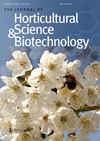Production of volatiles in brown boronia flowers after harvest. II: Effect of oxygen consumption
IF 2.1
4区 农林科学
Q2 HORTICULTURE
Journal of Horticultural Science & Biotechnology
Pub Date : 1999-01-01
DOI:10.1080/14620316.1999.11511134
引用次数: 1
Abstract
SummaryOxygen consumption in boronia flowers after harvest was correlated with production of volatiles. In some cases, exogenously applied respiratory inhibitors (NaN3, 2 mM and KCN, 100 mM and 3 mM) were not present in sufficient quantities to inhibit respiration, and yet production of volatiles was inhibited: indicating the action of cytoplasmic enzymes in the conversion of precursors into volatiles after harvest. Post-harvest respiration, whether via normal or alternative pathways, is a requirement for production of volatiles. Production of volatiles concurrent with activation of the alternative pathway may suggest that ATP may not be required. Large buds and open flowers consume three times as much oxygen as smaller buds after harvest: one reason for the reduced amounts of volatiles produced after harvest in small and medium sized buds, and in early stages of flowering.收获后褐硼砂花挥发物的产生。二、耗氧量的影响
收获后硼砂花的耗氧量与挥发物的产生有关。在某些情况下,外源应用的呼吸抑制剂(NaN3、2 mM和KCN、100 mM和3 mM)的数量不足以抑制呼吸,但挥发物的产生受到抑制:表明细胞质酶在收获后将前体转化为挥发物中的作用。收获后的呼吸,无论是通过正常途径还是其他途径,都是挥发物产生的必要条件。与替代途径激活同时产生的挥发物可能表明可能不需要ATP。大花蕾和开放的花朵在收获后消耗的氧气是小花蕾的三倍,这是收获后中小型花蕾和开花早期产生的挥发物量减少的一个原因。
本文章由计算机程序翻译,如有差异,请以英文原文为准。
求助全文
约1分钟内获得全文
求助全文
来源期刊
CiteScore
3.90
自引率
5.30%
发文量
67
审稿时长
3 months
期刊介绍:
The Journal of Horticultural Science and Biotechnology is an international, peer-reviewed journal, which publishes original research contributions into the production, improvement and utilisation of horticultural crops. It aims to provide scientific knowledge of interest to those engaged in scientific research and the practice of horticulture. The scope of the journal includes studies on fruit and other perennial crops, vegetables and ornamentals grown in temperate or tropical regions and their use in commercial, amenity or urban horticulture. Papers, including reviews, that give new insights into plant and crop growth, yield, quality and response to the environment, are welcome, including those arising from technological innovation and developments in crop genome sequencing and other biotechnological advances.

 求助内容:
求助内容: 应助结果提醒方式:
应助结果提醒方式:


